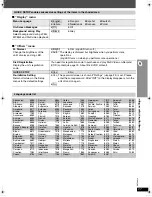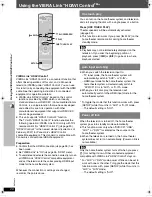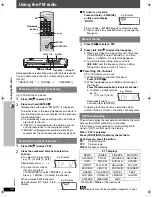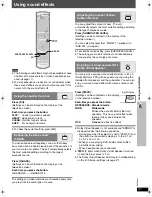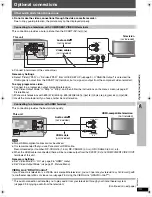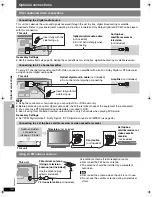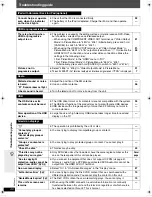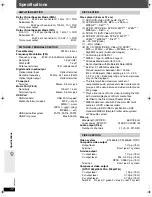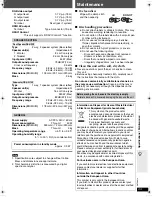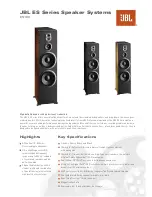
RQ
TX00
19
41
Glos
sar
y
Glossary
CPPM (Content Protection for Prerecorded Media)
A copy protection system used for DVD-Audio files. This
unit supports CPPM.
Decoder
A decoder restores the coded audio signals on DVDs to
normal. This is called decoding.
DivX
DivX is a popular media technology created by DivX, Inc.
DivX media files contain highly compressed video with
high visual quality that maintains a relatively small file size.
Dolby Digital
This is a method of coding digital signals developed by
Dolby Laboratories. Apart from stereo (2-channel) audio,
these signals can also be 5.1-channel sound.
Down-mixing
This is a process of remixing the 5.1-channel audio
(surround sound) on some discs into two channels. When
you want to listen to the audio on a DVD with a 5.1
channel digital surround track through your television
speakers, the down-mixed audio will be output.
Some DVD-Audio prevent down-mixing of all or part of
their contents. When playing such discs, or such parts of
the disc, unless the number of connected speakers is the
same as the disc’s channel specification, audio will not be
output properly.
DTS (Digital Theater Systems)
This surround system is used in many movie theaters
around the world. There is good separation between the
channels, so realistic sound effects are possible.
Dynamic range
Dynamic range is the difference between the lowest level
of sound that can be heard above the noise of the
equipment and the highest level of sound before
distortion occurs.
Film and video
DVD-Videos are recorded using either film or video. This
unit can determine which type has been used, then uses
the most suitable method of progressive output.
Film:
Recorded at 25 frames per second (PAL discs) or
24 frames per second (NTSC discs). (NTSC discs
recorded at 30 frames per second as well).
Generally appropriate for motion picture films.
Video:
Recorded at 25 frames/50 fields per second (PAL
discs) or 30 frames/60 fields per second (NTSC
discs). Generally appropriate for TV drama
programs or animation.
Frame still and field still
Frames are the still pictures that go together to make a
moving picture. There are about 30 frames shown each
second.
One frame is made up of two fields. A regular television
shows these fields one after the other to create frames.
A still is shown when you pause a moving picture. A
frame still is made up of two alternating fields, so the
picture may appear blurred, but overall quality is high.
A field still is not blurred, but it has only half the
information of a frame still so picture quality is lower.
HDMI (High-Definition Multimedia Interface)
HDMI is a next-generation digital interface for consumer
electronic products. Unlike conventional connections, it
transmits uncompressed digital video and audio signals on
a single cable. This unit supports high-definition video
output (720p, 1080i, 1080p) from the HDMI AV OUT
terminal. To enjoy high-definition video, a high-definition
compatible television is required.
JPEG (Joint Photographic Experts Group)
This is a system used for compressing/decoding colour
still pictures. The benefit of JPEG is less deterioration in
picture quality considering the degree of compression.
Linear PCM (pulse code modulation)
These are uncompressed digital signals, similar to those
found on CDs.
MP3 (MPEG Audio Layer 3)
An audio compression method that compresses audio to
approximately one tenth of its size without any
considerable loss of audio quality.
MPEG4
A compression system for use on mobile devices or a
network, that allows highly efficient recording at a low bit
rate.
Playback control (PBC)
If a Video CD has playback control, you can select
scenes and information with menus.
Progressive/Interlaced
The PAL video signal standard has 576 interlaced (i)
scan lines, whereas progressive scanning, called 576p,
uses twice the number of scan lines. For the NTSC
standard, these are called 480i and 480p respectively.
Using progressive output, you can enjoy the high-
resolution video recorded on media such as DVD-Video.
Your television must be compatible to enjoy progressive
video.
Sampling frequency
Sampling is the process of converting the heights of
sound wave (analog signal) samples taken at set periods
into digits (digital encoding). Sampling frequency is the
number of samples taken per second, so larger numbers
mean more faithful reproduction of the original sound.
WMA (Windows Media
TM
Audio)
WMA is a compression format developed by Microsoft
Corporation. It achieves the same sound quality as MP3
with a file size that is smaller than that of MP3.
0019EB_p28-44.fm Page 41 Monday, May 21, 2007 11:12 AM

